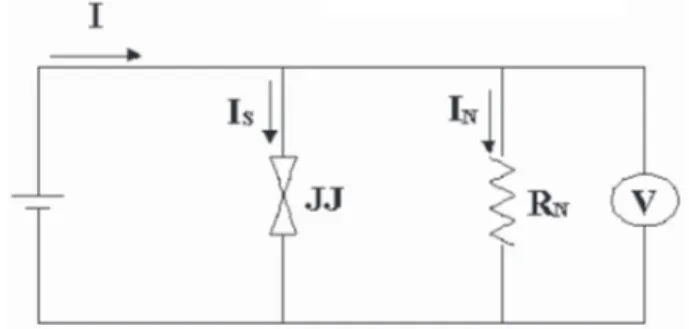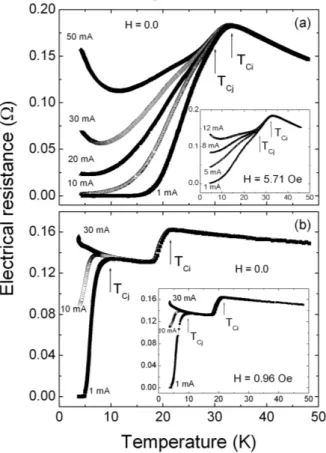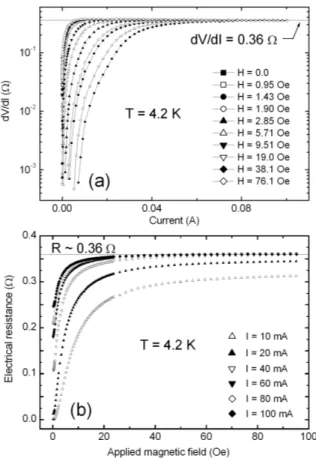Transport Properties of Granular High-T
CSuperconductors
M. S. da Luz, C. A. M. dos Santos, M. J. R. Sandim, A. J. S. Machado,
Escola de Engenharia de Lorena, Universidade de S ˜ao Paulo, P. O. Box 116, 12602-810, Lorena - SP, Brazil
and R. F. Jardim
Instituto de F´ısica, Universidade de S˜ao Paulo, P. O. Box 66318, 05315-970, S˜ao Paulo - SP, Brazil
Received on 18 June, 2007
We report on the application of the Resistively Shunted Junction (RSJ) model to granular highTC supercon-ductors. Some derived predictions of the RSJ model are applied to a set of superconducting granular samples which can be considered as a network of Josephson junctions. The investigated samples belong to both hole-dopedY1−xPrxBa2Cu3O7−δ (x= 0.0, 0.35, and 0.45) and the electron-doped Sm2−xCexCuO4−δ (x=0.18)
systems which display the so-called double resistive superconducting transition. We have performed several transport measurements in these compounds including temperature and magnetic field dependence of the elec-trical resistance,R(T,H), and I-V characteristics. Several aspects of the I-V characteristics were quantitatively well described by the RSJ model. The combined results strongly suggest that dissipation in granular super-conducting samples is a natural consequence of the normal current flowing in parallel with the supercurrent current.
Keywords: Granular superconductors; Double superconducting transition; Resistively shunted junction model
I. INTRODUCTION
In the last years, much attention has been dedicated to un-derstanding aspects related to superconductivity in granular and disordered systems [1-12]. One remarkable feature of granular superconductors is the occurrence of a double resis-tive superconducting transition [1-7]. Such a double transi-tion is noticeable by two well defined drops in the electrical resistance of a given superconducting material at two distinct temperatures labeledTci andTc j. The first superconducting transition, which occurs at an upper temperature Tci, is at-tributed to the development of superconductivity in isolated superconducting islands within the material. The second tran-sition, which eventually drives the system to the zero resis-tance state, occurs at Tc j<Tci. Such a transition is related to the long range phase coherence of the order parameter in which Josephson coupling between superconducting islands is achieved [1,3,5,6]
According to several authors [8,9,13-16], the dissipation in superconducting junctions is well described by the Resistively Shunted Junction (RSJ) model in which a normal current can flow in parallel with a supercurrent, as schematized in the cir-cuit displayed in Fig. 1. In such a circir-cuit, when the current exceeds the critical current of the junctionICa normal current flows in parallel with the supercurrent and dissipation process starts. Within this context, several works have been reported concerning the RSJ model applied to single grain-boundary Josephson junctions [14-16].
The RSJ model states that the total applied currentIwhich crosses a junction is given by:
I=IS+IN (1)
whereISis the supercurrent andIN is the normal current re-lated to the dissipation in the junction. The normal current is predicted to be described by
FIG. 1: Schematic diagram of the resistively shunted Josephson junc-tion model. RN and JJ are the shunt resistance and the Josephson junction, respectively.
IN=V/RN, (2)
whereRN is a normal state shunt resistance which is assumed to be magnetic field independent (see Fig. 1). Combining Eqs. (1) and (2) yields
V =RN(I−IS). (3) There are few points to be addressed in Eq. (3). First, when the total applied current is increased, the maximum supercur-rent through the junction is reached atIS=IC, whereICis the critical current of the junction. ForIS=IC and using Eq. (3) one is able to obtain
V=RNI, (5) must be reached. In addition to this one would expect a sat-uration of the magnetoresistance of the system starting when R=RN.
We mention that these predictions are different from those expected by the classical flux-flow model in which linear regimes in I-V characteristics atI>IC are magnetic field de-pendent(dV/dI∼H)[20,21].
Finally, going back to the Eq. (1), asIN increases there is a value ofIN in the I-V curve in whichIN reachesIS. At this point,I=2IN=2ISorIS=I/2 which provides (see Eq. 3)
V= (RN/2)I. (6)
In order to verify if the approaching of IN to IS is re-lated to the linear regime of an I-V curve, let us compare Eqs. (4) and (6). This procedure yields I=2IC and, con-sequently,IN=IS=IC. Such a result indicates that for values ofI=2IC a crossing point separating the non-linear from the linear regimes takes place in the I-V characteristics for each applied magnetic field. In the regime whereI<2IC, the be-havior of I-V curves is dominated by the supercurrent compo-nent (non-linear regime). On the other hand, forI>2IC, the dissipation is dominated by the single particle current and the I-V characteristics display linear regimes for applied magnetic fields.
In order to verify the applicability of the RSJ model to a system comprised of many Josephson junctions, we describe here a systematic investigation of transport properties in poly-crystalline samples exhibiting the double resistive supercon-ducting transition. The investigated samples belong to the hole-dopedY1−xPrxBa2Cu3O7−δ(x=0.0,0.35,and 0.45) and
electron-dopedSm2−xCexCuO4−δ (x=0.18) systems.
Fur-thermore this work provides experimental basis for the two-fluid model for transport properties of granular superconduc-tors published elsewhere [22].
II. EXPERIMENTAL PROCEDURE
Polycrystalline samples of the systemY1−xPrxBa2Cu3O7−δ
were prepared by the solid state reaction method. The pow-ders were mixed in appropriate amounts and sintered at differ-ent temperatures depending on sample composition. Phases were identified by X-ray powder diffractometry using Cu-Kα radiation. Optical and scanning electron microscopy revealed the granular structure of the samples. These results showed that the samples are single phase. Details about these proce-dures were already reported elsewhere [12].
All the samples were characterized by magnetotransport measurements. Copper electrical leads were attached to Au-film contact pads (contact resistance<1Ω)on parallelepiped-shaped samples using Ag epoxy. The applied electrical cur-rent was alternated in all measurements in order to elimi-nate the thermopower effects produced in the voltage con-tacts [24]. Conventional four-wire electrical resistance and magnetoresistance were performed in the limit of low applied magnetic fields, employing excitation current from 1 to 100 mA. The voltage versus excitation current I-V curves were performed for several values of applied magnetic field in the range 0≤H≤5000 Oe, employing excitation current up to about 50 mA. Before each measurement, the samples were cooled down from the normal state in zero applied magnetic field after which the magnetic field was turned on.
III. RESULTS AND DISCUSSION
Figure 2 shows the temperature dependence of the electrical resistance R(T) for Y0.55Pr0.45Ba2Cu3O7−δ and
Sm1.82Ce0.18CuO4−δsamples measured at zero and under
ap-plied magnetic field for several values of excitation current. From the figure we see that the double superconducting tran-sitions occur at temperaturesTciandTc j. The regime between
Tci andTc j is related to an ohmic behavior which has been attributed to an increasing of the volume fraction of super-conducting clusters with decreasing temperature [25]. This is much more pronounced inY0.55Pr0.45Ba2Cu3O7−δwhere a
systematic decrease inR(T)betweenTciandTc joccurs. SinceR(T) below Tc j for both samples is excitation cur-rent dependent one is able to assure that a non-ohmic regime appears due to the increasing I. This is the expected behav-ior in a system comprised of superconducting clusters linked by Josephson coupling. In such a system increasing excita-tion current results in a suppression of the coupling between superconducting clusters leading the system to a non-zero re-sistance state at low temperatures.
In order to further investigate the dissipation at tempera-tures belowTc j, we have measuredI−V characteristics for representative samples belonging to the Y1−xPrxCuO3O7−δ
andSm2−xCexCuO4−δ systems. The results of a set of I-V
characteristics for these samples measured at fixed tempera-tures, for different values of applied magnetic fields are dis-played in Fig. 3. From these curves it is clear that the I-V characteristics exhibit linear behavior at high applied excita-tion currents,I>IC, which are independent of the material.
FIG. 2: Temperature dependence of the electrical resistance for the (a) Y0.55Pr0.45Ba2Cu3O7−δ and (b) Sm1.82Ce0.18CuO4−δ samples
measured in different applied current and zero applied magnetic field. The insets show similar curves but under an applied magnetic field.
independent. Such a feature is supported by the results shown in Fig. 4.
We concentrate now in the linear regime of the I-V char-acteristics at high applied excitation currents (I >>IC)for theY0.55Pr0.45Ba2Cu3O7−δ sample. Fig. 4(a) shows the first
derivative of the V(I) curves displayed in Fig. 3(a), at sev-eral values of applied magnetic fields in the range 0≤H≤76 Oe. At high excitation currents, thedV/dI curves approach a constant value, a feature which is magnetic field indepen-dent. We emphasize that the linear behavior ofR(T)and its saturation under applied magnetic fields can not be explained within the context of the classical flux flow model. According to this model, the magnitude ofdV/dI is strongly magnetic field dependent as described in detail in the Ref. 21.
To gain further information regarding the behavior of the transport properties of this system let us compare the satura-tion value ofdV/dIat several applied magnetic fields (see Fig. 4(a)) with the magneto-resistance [R(H)≡V(H)/I] curves displayed in Fig. 4(b). These curves were obtained from mea-surements of R(H) when the system is subjected to differ-ent excitation currdiffer-ents at T =4.2K. The combined results indicates that ohmic behavior is only observed for high ap-plied magnetic fields (H>50 Oe) and high excitation cur-rents (I ≥20 mA). In addition to this, the data also show that the electrical resistance of the sample reaches a
satura-FIG. 3: I-V characteristics for the (a)Y0.55Pr0.45Ba2Cu3O7−δ and
(b)Sm1.82Ce0.18CuO4−δsamples measured at several values of
ap-plied magnetic field and atT=4.2 K. In the insets are shown similar results obtained at high excitation currents:Y Ba2Cu3O7−δ(top) and Y0.65Pr0.35Ba2Cu3O7−δ(bottom) at 77 and 34.5 K, respectively.
tion value close to 0.36Ω in both situations. It is important to notice that this ohmic resistance is related to the normal state shunt resistanceRN, as discussed before. Such a normal state is characterized by disconnected superconducting clus-ters, in which the normal state shunt resistance of the network of junctions was reached. This idea is supported by previous magnetotransport data of granular superconductors in which dissipation was argued to be ruled by the weak intergranular coupling and by intragranular flux flow at low and high mag-netic fields, respectively [25].
The values of RN are of interest for an analysis of the transport measurements discussed above and for a better un-derstanding of the RSJ model. Within this context, Fig. 5 displays in detail the I-V characteristics taken at 4.2 K and for several values of applied magnetic fields for the Y0.55Pr0.45Ba2Cu3O7−δ sample. A number of important
FIG. 4: (a) First derivative of the V versus I curves for the Y0.55Pr0.45Ba2Cu3O7−δsample (displayed in Fig. 3(a)). (b)
Mag-netoresistance curves taken atT=4.2 K when the sample was sub-jected to several values of the excitation current.
as expected from the RSJ model. ForH =0, for instance, IC∼33 mA and the crossing point occurs atI∼2IC∼66 mA. In high excitation current limit(I>2IC), all I-V curves are linear and exhibit a sloop very close toRN∼0.36Ω. It must be stressed that the results described above were observed in all I-V characteristics (not shown) taken at several temperatures T<TCj. These results indicate that the transport properties of
the investigated samples are in complete agreement with the predictions of the RSJ model.
Going further in the RSJ model, we have estimated the ex-citation current dependence of both the supercurrent(IS)and the normal current(IN)for theY0.55Pr0.45Ba2Cu3O7−δ
com-pound. In order to make that we have used theRNvalue (0.36 Ω) obtained for this compound (see Fig. 4) as well as the Eq. (1) and (2). RepresentativeIS(I)andIN(I)curves esti-mated from the I-V characteristics forY0.55Pr0.45Ba2Cu3O7−δ
at 4.2 K and underH=2.85 Oe (see Fig. 5(a)) are displayed in Fig. 6. From these curves one can see that the excitation current coincides with the supercurrent for low values of ex-citation current. With increasing applied current, IS reaches
IC at I=2IC (IS=IN =IC). Further increase of the exci-tation current leads IS to exhibit a saturation value. At this point, the excitation current dependence of the voltage is lin-ear, andI=IN+IC, whereIC is the maximum supercurrent
FIG. 5: Selected I-V characteristics under applied magnetic fields for theY0.55Pr0.45Ba2Cu3O7−δsample.RNandICare defined in the text.
FIG. 6: Excitation currentI dependencies of both supercurrent(IS) and normal current (IN). The solid lines were calculated by using Eqs. (1) and (2), and data of I-V characteristics for the compound Y0.55Pr0.45Ba2Cu3O7−δtaken atT=4.2 KunderH=2.85 Oe. The
inset shows the same curves in a log-log scale.
which crosses the network of junctions.
Based on the RSJ model and the experimental results above described we argue that the dissipation due to the normal current occurs in all applied current range studied. In fact, it vanishes at very low excitation current due to the detec-tion limit of the voltage instruments. Thus, whenI−→zero andI<<IC,IS>>IN, andI∼IS, which describes a zero-resistance(V −→0)superconducting state. For instance, at T =4.2 K,H=2.85 Oe, andI=10−4 mA,IS∼10−4mA andIN∼10−6mA, indicating thatINis nearly hundred times lower thanIS(see inset of the Fig. 6).
Finally, we have analyzed all the I-V characteris-tic curves for Sm1.82Ce0.18CuO4−δ, Y Ba2Cu3O7−δ, and
Y0.65Pr0.35Ba2Cu3O7−δcompounds using a similar procedure
as described in detail for theY0.55Pr0.45Ba2Cu3O7−δ. Similar
to these samples.
IV. CONCLUSION
In summary we have investigated the transport prop-erties of polycrystalline samples of both the hole-doped Y1−xPrxBa2Cu3O7−δ (x = 0.0, 0.35, and 0.45) and the
electron-dopedSm2−xCexCuO4−δ(x=0.18) systems. All the
investigated samples exhibit the double resistive supercon-ducting transition, a feature characterized by drops in the elec-trical resistivity data at two well defined temperaturesTciand
Tc j. We have found that, in the limit of high excitation current, the I-V characteristics taken atT belowTc jare linear for all the investigated samples. Most importantly it was also found that the slopes of the I-V characteristics at this high-current limit are magnetic field independent. The results obtained for
four different samples are in good agreement with the predic-tions of the RSJ model suggesting that dissipation in granular samples is a consequence of the normal current flowing in par-allel with the supercurrent. This experimental work has pro-vided support for the two-fluid model for transport properties of granular superconductors published elsewhere [22].
Acknowledgements
This work has been supported by the Brazilian agencies FAPESP (00/03610-4 and 97/11113-6), CNPq, and CAPES (0466/05-0). The authors are grateful to B. Ferreira for tech-nical assistance. Work at Universidade de S˜ao Paulo was sup-ported by FAPESP under Grant No. 05/53241-9. R. F. Jardim is a CNPq fellow under Grant No. 303272/2004-0.
[1] A. Gerber, T. Grenet, M. Cyrot, and J. Beille, Phys. Rev. Lett.
65, 3201 (1990).
[2] R. Gross, P. Chaudhari, D. Dimos, A. Gupta, and G. Koren, Phys. Rev. Lett.64, 228 (1990).
[3] A. Gerber, T. Grenet, M. Cyrot, and J. Beille, Phys. Rev. B43, 12935 (1991).
[4] J. J. Neumeier and M. B. Maple, Phys. C191, 158 (1992). [5] E. A. Early, C. C. Almasan, R. F. Jardim, and M. B. Maple,
Phys. Rev. B47, 433 (1993).
[6] R. F. Jardim, L. Ben-Dor, D. Stroud, and M. B. Maple, Phys. Rev. B50, 10080 (1994).
[7] D. G. Stell, J. D. Hettinger, F. Yuan, D. J. Miller, K. E. Gray, J. H. Kang, and J. Tavacchio, Appl. Phys. Lett.68, 120 (1996). [8] A. Barone, inPhysics and Applications of the Josephson Effect,
p. 122, ed. John Wiley and Sons (A Wiley-Interscience Publi-cation, New York),1982.
[9] A. J. Legget, InPercolation, Localization and Superconductiv-ity, p. 5, ed. A. M. Goldman and S. A. Wolf (Plenum Press, New York), 1983.
[10] P. L. Leath and W. Xia, Phys. Rev. B44, 9619 (1991). [11] E. Granato and D. Dom´ınguez, Phys. Rev. B56, 14671 (1997). [12] C. A. M. dos Santos and A. J. S. Machado, Phys. C354, 213
(2001).
[13] V. Ambegaokar and B. I. Halperin, Phys. Rev. Lett.22, 1364 (1969).
[14] C. M. Falco, W. H. Parker, S. E. Trullinger, and P. K. Hansma, Phys. Rev.10, 1865 (1996).
[15] C. L. Lin, W. J. Chang, M. Y. Li, C. H. Li, C. C. Chi, and M. K. Wu, Phys. C269, 291 (1996).
[16] J. C. Gallop; inSQUIDS, The Josephson Effects and Supercon-ducting Electronics, Adam Hilger, 1991, p. 26.
[17] E. B. Sonin, JETP Lett.47, 497(1988).
[18] E. B. Sonin and A. K. Tagantsev, Phys. Lett. A140, 127 (1989). [19] L. Ji, M. S. Rzchowski, N. Anand, and M. Tinkham, Phys. Rev.
B47, 470 (1993).
[20] J. Bardeen and M. J. Stephen, Phys. Rev.140, A1197 (1965). [21] R. P. Huebener, inMagnetic Flux Structures in
Superconduc-tors, Springer Series in Solid-State Science 6. Ed. Springer-Verlag (Berlin Heidelber New York, 1979).
[22] C. A. M. dos Santos, C. J. V. Oliveira, M. S. da Luz, A. D. Bortolozo, M. J. R. Sandim, and A. J. S. Machado, Phys. Rev. B74, 184526 (2006).
[23] R. F. Jardim, L. Ben-Dor, and M. B. Maple, J. Alloys and Comp.199, 105 (1993).
[24] M. S. Fuhrer, K. Ino, K. Oka, Y. Nishihara, and A. Zettl, Solid State Commun.101, 841 (1997).


